After years of uncertainty, the final volumes for the amount of corn ethanol were announced late last year, and corn ethanol is essentially at its limit under the RFS, according to Doug Durante, Clean Fuels Development Coalition (CFDC) executive director.
 Durante gave a recap of the Renewable Fuels Standard (RFS) and what it means for the ethanol industry during a Nebraska Ethanol Board meeting Jan. 21 in Lincoln. He discussed the regulatory roadblocks that, if eliminated, would open the market for higher ethanol blends.
Durante gave a recap of the Renewable Fuels Standard (RFS) and what it means for the ethanol industry during a Nebraska Ethanol Board meeting Jan. 21 in Lincoln. He discussed the regulatory roadblocks that, if eliminated, would open the market for higher ethanol blends.
“The RFS helped kick start the significant volumes of ethanol production we see today, but we cannot rely on the RFS to ensure a continued market,” Durante said. “The industry needs to grow beyond the RFS and create new, consumer-driven demand that capitalizes on the health benefits of ethanol’s clean octane and the ability to meet low-carbon fuel standards.”
Durante suggested that ethanol advocates find additional pathways to create market demand that allows the industry to move beyond the RFS volume obligations. He noted that eliminating the following burdens on ethanol would help create more opportunities for ethanol:
- Removing unnecessary seasonal Reid Vapor Pressure (RVP) restrictions
- Raising the minimum octane for fuel
- Enforcing limitations on levels of toxic aromatics in gasoline
- Correcting the flawed EPA MOVES model and lifecycle analysis
- Reinstating meaningful flex fuel vehicle (FFV) credits for vehicle manufacturers
- Streamlining the certification of higher ethanol blends up to E30
“Given the restrictions and possible expiration of the RFS, the transition to more open and free ethanol markets must begin now,” explained Durante. “Ethanol production and utilization has only scratched the surface of its potential.”

